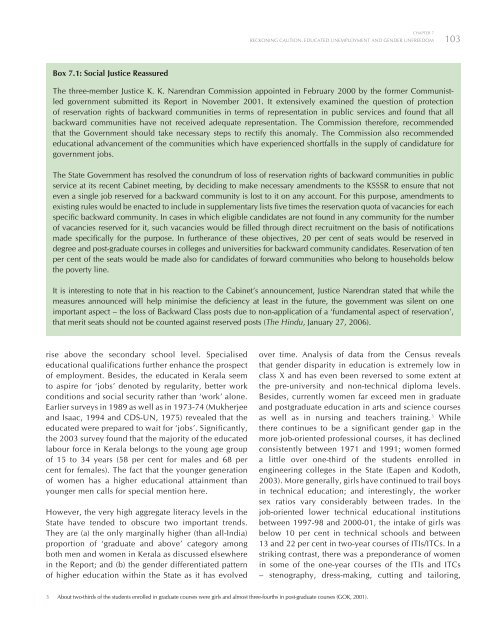Kerala 2005 - of Planning Commission
Kerala 2005 - of Planning Commission
Kerala 2005 - of Planning Commission
You also want an ePaper? Increase the reach of your titles
YUMPU automatically turns print PDFs into web optimized ePapers that Google loves.
CHAPTER 7<br />
RECKONING CAUTION: EDUCATED UNEMPLOYMENT AND GENDER UNFREEDOM<br />
103<br />
Box 7.1: Social Justice Reassured<br />
The three-member Justice K. K. Narendran <strong>Commission</strong> appointed in February 2000 by the former Communistled<br />
government submitted its Report in November 2001. It extensively examined the question <strong>of</strong> protection<br />
<strong>of</strong> reservation rights <strong>of</strong> backward communities in terms <strong>of</strong> representation in public services and found that all<br />
backward communities have not received adequate representation. The <strong>Commission</strong> therefore, recommended<br />
that the Government should take necessary steps to rectify this anomaly. The <strong>Commission</strong> also recommended<br />
educational advancement <strong>of</strong> the communities which have experienced shortfalls in the supply <strong>of</strong> candidature for<br />
government jobs.<br />
The State Government has resolved the conundrum <strong>of</strong> loss <strong>of</strong> reservation rights <strong>of</strong> backward communities in public<br />
service at its recent Cabinet meeting, by deciding to make necessary amendments to the KSSSR to ensure that not<br />
even a single job reserved for a backward community is lost to it on any account. For this purpose, amendments to<br />
existing rules would be enacted to include in supplementary lists five times the reservation quota <strong>of</strong> vacancies for each<br />
specific backward community. In cases in which eligible candidates are not found in any community for the number<br />
<strong>of</strong> vacancies reserved for it, such vacancies would be filled through direct recruitment on the basis <strong>of</strong> notifications<br />
made specifically for the purpose. In furtherance <strong>of</strong> these objectives, 20 per cent <strong>of</strong> seats would be reserved in<br />
degree and post-graduate courses in colleges and universities for backward community candidates. Reservation <strong>of</strong> ten<br />
per cent <strong>of</strong> the seats would be made also for candidates <strong>of</strong> forward communities who belong to households below<br />
the poverty line.<br />
It is interesting to note that in his reaction to the Cabinet’s announcement, Justice Narendran stated that while the<br />
measures announced will help minimise the deficiency at least in the future, the government was silent on one<br />
important aspect – the loss <strong>of</strong> Backward Class posts due to non-application <strong>of</strong> a ‘fundamental aspect <strong>of</strong> reservation’,<br />
that merit seats should not be counted against reserved posts (The Hindu, January 27, 2006).<br />
rise above the secondary school level. Specialised<br />
educational qualifications further enhance the prospect<br />
<strong>of</strong> employment. Besides, the educated in <strong>Kerala</strong> seem<br />
to aspire for ‘jobs’ denoted by regularity, better work<br />
conditions and social security rather than ‘work’ alone.<br />
Earlier surveys in 1989 as well as in 1973-74 (Mukherjee<br />
and Isaac, 1994 and CDS-UN, 1975) revealed that the<br />
educated were prepared to wait for ‘jobs’. Significantly,<br />
the 2003 survey found that the majority <strong>of</strong> the educated<br />
labour force in <strong>Kerala</strong> belongs to the young age group<br />
<strong>of</strong> 15 to 34 years (58 per cent for males and 68 per<br />
cent for females). The fact that the younger generation<br />
<strong>of</strong> women has a higher educational attainment than<br />
younger men calls for special mention here.<br />
However, the very high aggregate literacy levels in the<br />
State have tended to obscure two important trends.<br />
They are (a) the only marginally higher (than all-India)<br />
proportion <strong>of</strong> ‘graduate and above’ category among<br />
both men and women in <strong>Kerala</strong> as discussed elsewhere<br />
in the Report; and (b) the gender differentiated pattern<br />
<strong>of</strong> higher education within the State as it has evolved<br />
over time. Analysis <strong>of</strong> data from the Census reveals<br />
that gender disparity in education is extremely low in<br />
class X and has even been reversed to some extent at<br />
the pre-university and non-technical diploma levels.<br />
Besides, currently women far exceed men in graduate<br />
and postgraduate education in arts and science courses<br />
as well as in nursing and teachers training. 3 While<br />
there continues to be a significant gender gap in the<br />
more job-oriented pr<strong>of</strong>essional courses, it has declined<br />
consistently between 1971 and 1991; women formed<br />
a little over one-third <strong>of</strong> the students enrolled in<br />
engineering colleges in the State (Eapen and Kodoth,<br />
2003). More generally, girls have continued to trail boys<br />
in technical education; and interestingly, the worker<br />
sex ratios vary considerably between trades. In the<br />
job-oriented lower technical educational institutions<br />
between 1997-98 and 2000-01, the intake <strong>of</strong> girls was<br />
below 10 per cent in technical schools and between<br />
13 and 22 per cent in two-year courses <strong>of</strong> ITIs/ITCs. In a<br />
striking contrast, there was a preponderance <strong>of</strong> women<br />
in some <strong>of</strong> the one-year courses <strong>of</strong> the ITIs and ITCs<br />
– stenography, dress-making, cutting and tailoring,<br />
3 About two-thirds <strong>of</strong> the students enrolled in graduate courses were girls and almost three-fourths in post-graduate courses (GOK, 2001).

















